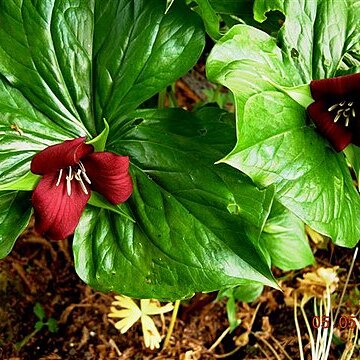Rhizomes horizontal–slightly erect, thick, praemorse. Scapes 1–4+, round in cross section, 3–7 dm, 2–2.5 times as long as bract, stout, glabrous. Bracts subsessile; blade obovate to broadly elliptic, 13–20 × 8–22 cm, not glossy, base attenuate, apex acuminate. Flower facing outward at right angle to pedicel, above bracts, odor faintly musty, like fresh fungus; perianth gaping, strongly 3-dimensional; sepals spreading, usually streaked or entirely purplish maroon, occasionally entirely green except on margins, elliptic, 15–38 × 9–15 mm, margins entire, apex strongly sulcate-acuminate; petals carried somewhat forward to recurved-spreading in distal 1/2, usually dark reddish maroon to purplish, rarely cream to soft yellow, pink, white, or 2-colored, heavy-veined, ovate to broadly ovate-overlapping, 1.8–5 × 1–3 cm, heavy-textured, apex acuminate, rarely somewhat sulcate; stamens erect, ± equaling or slightly longer than ovary, 15–18 mm; filaments purple to white, 3–5 mm, slender; anthers straight, purplish to yellow, 5–12 mm, thick, dehiscence introrse; connectives equaling or ± shorter than anther sacs; ovary usually dark purple, globose to flask-shaped, 6-angled, 14–18 mm, broadly attached basally; stigmas prominent, recurved, distinct, purple, not lobed adaxially, basally thickened, gradually tapered, 2–5 mm, fleshy; pedicel usually stiffly erect (rarely almost horizontal above bracts), straight, reflexed ± 90° at tip, 6–11 cm. Fruits red, fragrance of fresh mushrooms, ± globose to pyramidal, 1.5–3 × 1.2–2.8 cm, juicy to pulpy. 2n = 10.
More
Much like no. 6 [Trillium erectum L.]; fls scarcely foetid; peduncle longer, mostly 5–9+ cm and more than twice as long as the distally sulcate sep; pet ascending below, concealing the ovary from side-view, recurved-spreading above; filaments longer, ca half or two-thirds as long as the anthers, which usually surpass the ovary; 2n=10. Moist rich woods; s. Appalachian region, from w. Va., s. W.Va., and e. Ky. to nw. Ga. and ne. Ala. Apr., May.


